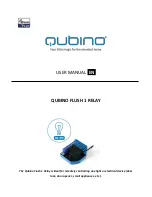
Westinghouse
I.L. 41-103H
TYPE CO CIRCUIT OPENING
OVERCURRENT RELAY
.
.
.
.
. .
. .
.
.
.
.
.
CAUTION
Before putting relays into service, remove all
blocking which may have been inserted for the
purpose of securing the parts during shipment,
make sure that all moving parts operate freely,
inspect the contacts to see that they are clean
and close properly, and operate the relay to check
the settings and electrical connections.
APPLICATIOI'\1
These induction overcurrent relays are used to
disconnect circuits or apparatus when the current
in them exceeds a given value. When no suitable
station battery is available, the circuit opening
type relay in conjunction with a-c series trip coil
is used to trip the circuit breaker.
CONTENTS
This instruction leaflet applies to the following
types of circuit opening relays:
Type C0-2 Short Time Relay
Type C0-5 Long Time Relay
Type
C0-6
Definite Minimum Time Relay
Type C0-7 Moderately Inverse Time Relay
Type C0-8 Inverse Time Relay
Type C0-9 Very Inverse Time Relay
Type C0-11 Extremely Inverse Time Relay
CONSTRUCTION AND OPERATION
The type CO relays consist of an overcurrent
unit (CO), a de-ion contactor switch (CS), an op
eration indicator (01) and an indicating instan
taneous trip (liT) when required.
ELECTROMAGNET
The electromagnets for the types C0-5, C0-6,
CO-7, C0-8 and C0-9 relays have a main tapped
coil located on the center leg of an "E" type
laminated structure that produces a flux which
divides and returns through the outer legs. A
shading coil causes the flux through the left leg
to lag the main pole flux. The out-of-phase fluxes
thus produced in the air gap cause a contact
closing torque.
The electromagnets for the types C0-2 and
CO-Il relays have a main coil consisting of a
tapped primary winding and a secondary winding.
Two identical coils on the outer legs of the lami
nation structure are connected to the main coil
secondary in a manner so that the combination
of all the fluxes produced by the electromagnet
result in out-of-phase fluxes in the air gap. The
out-of-phase air gap fluxes produced cause a con
tact closing torque.
DE-ION CONTACTOR SWITCH (CS)
This switch is a small a-c solenoid switch
whose coil is energized from a small transformer
connected in the main current circuit. A cylin
drical plunger operates a spring leaf arm with a
silver contact surface on one end and rigidly fixed
to the frame at the other end.
The overcurrent unit contacts are in the con
tactor switch coil circuit and when they close, the
solenoid plunger moves upward to open the de
ion contacts which normally short circuit the trip
coil. These contacts are able to transfer the heavy
current due to a short circuit and permit this cur
rent to energize the breaker trip coil.
All possible contingencies which may arise during installation, operation, or maintenance, and all
details and variations of this equipment do not purport to be covered by these instructions. !/further
information is desired by purchaser regarding his particular ins lallation, operation or maintenance of
his equipment, the local Westinghouse Electric Corporation representative should be contacted.
SUPERSEDES
I.L.
41-103G DATED JUNE 1976
ODENOTES CHANGED SINCE PREVIOUS ISSUE
EFFECTIVE MAY 1984
www
. ElectricalPartManuals
. com

































